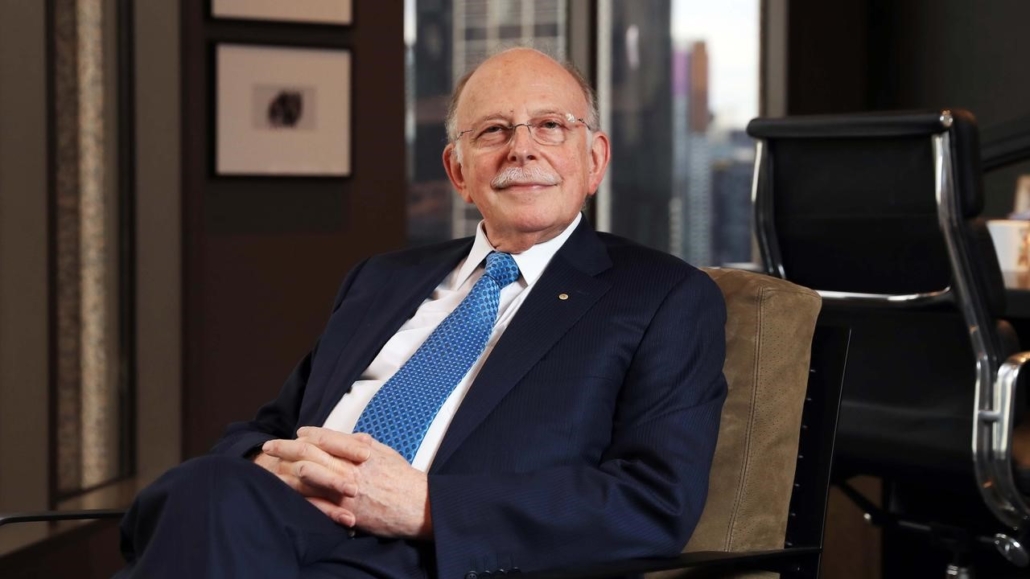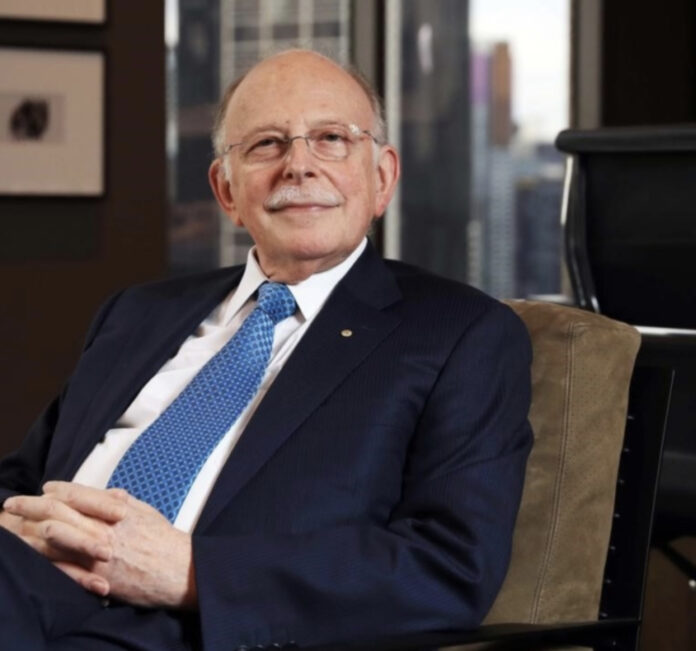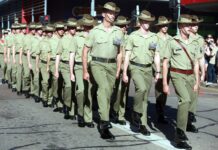
Editor’s Note: This week will feature a series of articles written by Brenton Sanderson, courtesy of The Occidental Observer. They focus on the role of jewish ethnic lobby groups and in particular Mark Leibler in pushing “diversity” and mass immigration on an Australia that never asked for it.
Furthermore, while XYZ News has focused on the role of Marxists, political aborigines and international institutions in foisting “the voice” referendum upon us, it is important to understand the motives of jewish ethnic lobbyists who are fellow architects of the so-called “voice to parliament”.
In writing about the pivotal Jewish role in Australia’s demographic revolution (triggered by the liberalization of immigration laws and institutionalization of multiculturalism), I have had regular occasion to mention the name “Leibler.” Among Jewish leaders in Australia in recent decades, none have enjoyed greater prominence than brothers Isi and Mark Leibler. I had long intended to devote an entire essay to the Leiblers and their impact on Australian politics and society, and was recently prompted to do so by the publication of the book The Powerbroker: Mark Leibler, An Australian Jewish Life by the Jewish journalist Michael Gawenda. After sampling some excerpts, I ordered the book and powered through it in a couple of days. While already familiar with the most of its contents, the biography contains some fascinating (and surprisingly revealing) material.
Gawenda’s stated reason for writing The Powerbroker is strangely paradoxical. He claims to have been impelled to write about Australia’s most powerful and politically well-connected Jewish leader by the rise of anti-Semitism in Australia and elsewhere. “The time was right,” he claims. “Anti-Semitism of the right and the left was on the rise. … For the first time, I had a growing sense of foreboding about the future of the Jews. I wondered whether that time after the Holocaust – the time in which Leibler and I grew up and lived most our lives, when anti-Semitism was totally unacceptable and anti-Semites were given no oxygen, no legitimacy – was over.”[1] Gawenda’s bizarre response to this alleged phenomenon was to pen a work confirming the veracity of various anti-Semitic “tropes” and “canards.” The Powerbroker unashamedly affirms the extraordinary power, wealth and political influence of organized Jewry in Australia – and its most prominent leader. For Gawenda:
Leibler’s life is a story about Jews and power. Making that connection is fraught with risks, for it is one that has been made throughout history by anti-Semites and by those who think Jews somehow have an almost magical ability to influence and change – always for self-interest and for the worst – the course of history. Questions about Jewish power have consumed Jew-haters, and their answers have led to discrimination and hatred and, sometimes, to unspeakable, historically unprecedented violence. But just because anti-Semites believe the Jews have power does not mean it is untrue. Leibler’s story cannot be told without an examination of the way he has developed and used power and influence.[2]
Gawenda’s willingness to openly discuss the extraordinary power and influence of Jews in Australia, despite this endeavor being “fraught with risks,” troubled one reviewer of The Powerbroker, the Jewish academic Phillip Mendes, who warned that “This narrative may excite some conspiracy theorists on the far left and right who believe that Jews per se control finance.”[3] Mendes falsely claimed in his review that 30 percent of Australian Jews live in poverty.
Gawenda’s first interactions with his biographical subject were when, as editor of The Age newspaper in Melbourne in the 1990s, the Australia/Israel & Jewish Affairs Council (AIJAC), the lobby group then (and still) chaired by Leibler, contacted him “regularly to complain rather robustly about the newspaper’s coverage of the Middle East.”[4] Gawenda did not always need AIJAC’s “robust” advice to sway the newspaper’s coverage of the Middle East in his own ethnic interests. As editor he censored political cartoons critical of Israel, a practice that prompted one observer to demand he openly declare his Jewish ethnicity. Gawenda found this deeply offensive, with its suggestion that “a Jew writing about another Jew was somehow problematic. And it could only be considered problematic if you thought that Jews stuck together, that their first loyalty was always to each other, that Jews, in other words, had dual and even conflicting loyalties. For Jews, this is an association with a long and bloody history, and it has, no doubt, been leveled at Mark Leibler.”[5]
Michael Gawenda
Gawenda identifies as a child of “Holocaust survivors” despite the fact his parents sat out World War Two in the far-east of Russia. They were, he claims, part of “the influx of more than 20,000 Holocaust survivors [to Australia] after the war, more of whom settled in Australia proportionately than in any other country other than Israel.”[6] The father of his biographical subject arrived in Australia just prior to World War Two. An Orthodox religious Zionist and diamond dealer from Antwerp who arrived in 1938 on a business trip, Abraham Leibler was prompted to stay by the situation in Europe, and was joined by his wife Rachel and firstborn son Isi in Melbourne later that year. At that time, there were then no obstacles for Jews leaving Belgium to sell their property and take their wealth with them. Isi Leibler’s younger brother, Mark, was later born in Melbourne in 1943.
Abraham set up his diamond business in Melbourne at the time when, under the influence of the White Australia policy, Australia was one of the Whitest countries in the world with the non-European population, other than Aborigines, being measured at around 0.25 per cent of the total. The population was predominantly of Anglo-Celtic origin and Australians of the other European ethnicities were thoroughly assimilated into the Anglo-Australian mainstream. Apart from the Protestant-Catholic sectarian divide, Australia was a culturally-cohesive nation devoid of significant social tensions. Reflecting on this, Gawenda sourly observes that “In those days the word ‘diversity’ pertained only to plant and animal species, not to human beings, and the word ‘multicultural’ was still many decades away from being a description of Australian society.”[7] Gawenda’s own ethnic group would play a pivotal role in that social transformation.
Abraham Leibler arrived in an Australia that was “was monocultural and before the arrival of hundreds of thousands of migrants from Europe in the 1950s, ethnically homogeneous.”[8] Even this post-War influx of some 200,000 European migrants to Australia did not, however, greatly change things. Northern European migrants were prioritized and expected to assimilate into the general Australia community as quickly as possible (which they did). Moreover, throughout the 1950s more migrants continued to arrive in Australia from Britain than from any other place.
At the time of Abraham Leibler’s arrival in 1938, the Australian Jewish population were predominantly “Anglo Jews” – the descendants of German Jews who arrived in Australia during the gold rushes of the mid to late-nineteenth century. These Jews were well integrated into the political and administrative structure of the colonies and gained social acceptance through adoption of British customs and displays of loyalty to the British Empire. Sir John Monash (1865–1931), for example, became a general in the Australian army and was, according to Goldberg, “the only Jew in the modern era outside Israel (with the exception of Trotsky) to lead an army.”[9] Sir Isaac Isaacs (1855–1948) became Australia’s first native-born Governor-General. In Australia under the Immigration Restriction Act of 1901, these highly-assimilated Anglo-Jews were regarded as “White,” while Jews of Middle-Eastern origin were regarded as Asian and therefore barred from entry.
Alongside these culturally-assimilated Anglo Jews was a smaller group of Eastern European Jews noted for their ferocious ethnocentrism and political radicalism. These Jews arrived as refugees from Tsarist Russia from 1880 to 1914, and from Poland after 1918. The numbers arriving with each of these waves were, however, comparatively small and Australian Jewry remained a tiny isolated outpost of world Jewry until the 1930s.[10]In this decade, Australia accepted an influx of 7,000 Jews as refugees under the Australian government’s quota for Jews fleeing National Socialist Germany. Gawenda notes how these new Jews, and the post-war Jewish influx of “Holocaust survivors” from Eastern Europe, “were radically different to the Anglo Jews. They spoke mainly Yiddish and were steeped in Yiddish culture and traditions. Critically, they did not define their Jewishness narrowly, as a matter of religious adherence. Many were Zionists who believed in Jewish nationhood.”[11]
Many were also avowed communists who created and supported a communist front group called the Jewish Council to Combat Fascism and Anti-Semitism. Formed during the war, this organization became a major force in Australian Jewish community politics, with its leaders and members being overwhelmingly “either communists or fellow travelers.”[12] From these politically radical Eastern European Jewish migrants emerged one of the Soviet Union’s most successful spy rings. In his book Traitors and Spies: Espionage and Corruption in Hugh Places in Australia, 1901–-50, former intelligence officer John Fahey describes how “respected Jewish businessmen” Jack Skolnik, Hirsch Munz and Solomon Kosky “established themselves as what I believe is probably the most successful spy ring that’s ever operated in Australia. I have no doubt they stole vast amounts of information.”[13] This trio passed on valuable military and political secrets to Moscow, undetected, from government offices in Melbourne from the late 1920s right through to the 1950s.
The Anglo Jews feared the intense ethnocentrism and political radicalism of these new Jewish arrivals would provoke an increase in anti-Semitism — and their fears were not without foundation. The new migrants had the effect of making the Anglo-Jews more visible as a group through their association with the new European Jews. They also provoked hostility from significant sections of the Australian community, who (correctly) sensed that these psychologically-intense and politically-radical newcomers posed an existential threat. The Anglo-Jewish leadership feared these new Jews, who were “Zionists of the most visceral kind,” would provoke the charge of dual loyalty recurrently made regularly against Jews in Europe: that Jews were only loyal to each other and not to the countries in which they lived. Gawenda observes that:
Sometimes the dual loyalties charge was expressed as an accusation that Jews were a fifth column of traitors hidden in the population. Hitler famously ranted about the Jewish stab-in-the-back of the German people during World War I. It was, however, a relatively new concept in Australia, where, until the arrival of the refugee Jews in the 1930s, Australia’s Anglo Jews had, in the main, done everything they could to avoid being accused of such a terrible thing. After the establishment of Israel, the dual loyalties’ charge morphed into a charge that Jews were more loyal to Israel than to countries where they lived and often had lived for generations.[14]
The battle between the established Anglo-Jewish community and the newcomers from Central and Eastern Europe was essentially a battle between proponents of cultural assimilation and proponents of Jewish separatism. The new Jewish migrants were “not about to ‘complete Hitler’s work,’ as many of them put it, by assimilating.”[15] Even when in Europe they had considered themselves Jews first and foremost. “They were well-versed in Jewish scholarship, often deeply religious and in many cases, passionately Zionist,” notes the Australian-Jewish historian Suzanne Rutland.[16] The new Jews, through the activism of community leaders like Walter Lippmann (who arrived in Australia in 1938), were to be pivotal to entrenching cultural pluralism and “multiculturalism” as official Australian government policy from the 1970s.
Lippmann resented the expectation to assimilate into the Anglo-Australian mainstream. In his advocacy of the multiculturalism in Australia, he tore a page out of the writings of the pioneering Jewish-American multiculturalist Horace Kallen. Lippmann believed Jewish immigrants had left one type of oppression behind only to be subjected to another – the Australian expectation to assimilate. Kallen described the corresponding expectation in the early twentieth-century United States as “the Americanization hysteria” or the “Americanization psychosis.”[17] The multiculturalism espoused by Lippmann, which ultimately became the basis for social policy in Australia, implied “a rejection not only of the attempts to promote an amalgam of cultures but also of any assumptions of Anglo-Saxon superiority and the necessary conformity to English-oriented cultural patterns.”[18]
The Leiblers, as Orthodox Jews and Zionists, openly flouted the expectation to assimilate and lived in a completely Jewish milieu sealed off from the surrounding Australian society. This stance was intensified by their involvement with Mizrachi, a religious Zionist organization that functioned like a self-contained community, with its own synagogues, day schools and youth movement, Bnei Akiva – named after Rabbi Akiva, a rabbinical authority on Judaism’s major texts, who was executed by the Romans after the failed Jewish revolt against Roman rule in AD 66.
The Leiblers were far from alone in their determination to resist assimilation and promote Jewish genetic and cultural separation from the general Australian community. A group of businessmen and activists raised money to establish a Jewish day school in 1949, Mount Scopus College, in Melbourne – which eventually grew into the largest Jewish day school in Australia and one of the biggest in the world. Mark Leibler attended the college, which catered to “a wide range of parents, from the Orthodox to those who wanted their children to go to a Jewish school in order to minimize the chances of their ‘marrying out.’” These parents were most concerned about “maximizing the chances of their children getting good Year 12 exam scores and marrying other Jews.”[19] Such was the insularity of the Mark Leibler’s upbringing and early life in Melbourne that he observed: “I don’t think I had any non-Jewish friends. I was basically mixing with Jews all the time.”[20]
Despite this, reflecting back on his time as a student at Mount Scopus, Leibler thought the school had not done enough to foster a “deep sense of their Jewish identity, a knowledge of and love for Judaism as bulwarks against assimilation and intermarriage.” He believed Australian Jewish children needed “schools with clear ideologies that fostered their particular kind of Jewish identity.” He later supported and sent all of his children to Yavneh College – a Zionist and Modern Orthodox school absolutely committed to producing “Jews secure in their Jewishness, knowledgeable about and able to practice Judaism with an unshakable commitment to Israel.”[21]

Mark Leibler first interacted with non-Jews when he studied law at the University of Melbourne. Even there, he was, however, taught and mentored by several Jewish academics including Zelman Cowen, the Dean of Law who helped get him into the Masters program at Yale. Jewish ethnic networking also played an inevitable role in determining where Leibler launched his legal career: he did his articles at the law firm of Arnold Bloch in 1966, whose eponymous owner was “a family friend and Jewish community leader who had known Mark since he was a boy.”[22] Leibler subsequently joined the firm and was quickly made an associate. Within a decade and a half, many of the firm’s mostly Jewish clients were among Australia’s richest people. One of Bloch’s first clients in the 1950s was John Gandel, the now billionaire property developer and leading funder of Jewish causes.
In the decade to 1957, the Australian Jewish community had almost doubled in size, from about 32,000 to more than 55,000 with the vast majority living in Sydney and Melbourne. By 1957, the new Jewish migrants from Central and Eastern Europe outnumbered the Anglo Jews and had taken over the leadership of all Jewish organizations. It was out of this group that Isi and Mark Leibler emerged as leaders in the 1960s and 1970s. Mark focused his leadership ambitions on the Australian Zionist organizations – the State Zionist Council of Victoria and the national Zionist Federation of Australia, which was affiliated to the World Zionist Organization. His brother Isi had already risen to become president of Victorian Jewish Board of Deputies and an internationally recognized leader of the campaign to allow Soviet Jews to migrate to Israel. His activism is said to have been strongly shaped by “the Holocaust” which was always “uppermost in Isi Leibler’s mind.”[23]
Since the late 1990s, when Isi settled in Israel, Mark Leibler has been recognized as “Australia’s most influential and powerful Jewish leader, and has become increasingly influential in international Jewry.”[24] The Jerusalem Post accorded him the status of one of the world’s 50 most influential Jews – a leader of Jews both in Australia and around the world. Gawenda notes that while Leibler “is not well known to most Australians,” his influence “far exceeds his public profile” and he is “regularly sought out by powerful people in all walks of life.”[25] Ultimately, this power and influence is “built on the strength of the 120,000 in Australia’s Jewish community.”[26] In the subsequent parts of this essay, I explore Mark Leibler’s impact on Australian politics and society.
Originally published at The Occidental Observer on December 4, 2020.
Brenton Sanderson is the author of Battle Lines: Essays on Western Culture, Jewish Influence and Anti-Semitism, available here and here.
[1] Michael Gawenda, The Powerbroker: Mark Leibler, An Australian Jewish Life (Melbourne: Monash University Publishing, 2020), 6.
[2] Ibid., 11-12.
[3] Philip Mendes, “The many sides of Mark Leibler,” The Sydney Morning Herald, September 11. https://www.smh.com.au/culture/books/the-many-sides-of-mark-leibler-20200903-p55s5a.html
[4] Gawenda, The Powerbroker, 9.
[5] Ibid., 10.
[6] Ibid., 7.
[7] Ibid., 16.
[8] Ibid., 20.
[9] Dan Goldberg “After 9/11: The Psyche of Australian Jews,” In: New Under the Sun – Jewish Australians on Religion, Politics & Culture, Ed. Michael Fagenblat, Melanie Landau & Nathan Wolski (Melbourne: Black Inc., 2006) 140-152, 151.
[10] Suzanne Rutland, The Jews in Australia (Melbourne: Cambridge University Press, 2005), 22.
[11] Gawenda, The Powerbroker, 18.
[12] Ibid., 24.
[13] Jen Kelly, “How three Melbourne businessmen became one of the Soviets’ most successful spy rings, Herald-Sun, October 9.
[14] Gawenda, The Powerbroker, 21.
[15] Ibid., 36.
[16] Rutland, The Jews in Australia, 77
[17] Horace Kallen, Culture and Democracy in the United States (New York: Arno Press, 1924; reprint 1970), 165; 167.
[18]http://www.immi.gov.au/media/publications/multicultural/confer/06/speech29a.htm
[19] Gawenda, The Powerbroker, 81.
[20] Ibid., 33.
[21] Ibid., 81.
[22] Ibid., 48.
[23] Ibid., 23.
[24] Ibid., 4.
[25] Ibid., 2.
[26] Ibid., 4.










